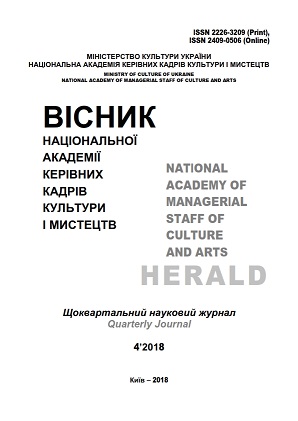Socio-Cultural Value of Television as a Screen Form of Art in Shaping the Outlook of a Young Spectator
Socio-Cultural Value of Television as a Screen Form of Art in Shaping the Outlook of a Young Spectator
Author(s): Tetyana Oleksandrivna KravchenkoSubject(s): Media studies, Culture and social structure , Sociology of Culture, Marketing / Advertising
Published by: Національна академія керівних кадрів культури і мистецтв
Keywords: television; influence; children; advertising;
Summary/Abstract: The purpose of the article is to investigate the influence of television on a child. The methodology of the research consists in application of general scientific and specific scientific methods: analytical - for the study of philosophical, cultural, literary literature on the topic, the disclosure of the essence of television as a socio-cultural phenomenon; theoretical - to generalize the theoretical positions and observations on the nature of the influence of television broadcasting on television audience; historical - to systematize information on the history of the development of television broadcasting and floating; comparative - to determine the general and specific features of the programs of modern television in different countries of the world. Scientific novelty consists in the study of television as an on-screen art tool that can influence, in particular, the outlook of the young viewer and shape the outlook of a new generation of screen culture consumers. Television is a young form of art, so the means of its influence on a viewer are in the stage of development and improvement. One of them is the phenomenon of absolute realism. But, at the same time, television in its daily interpretation of reality predicts a certain emotional and psychological effect in the audience, having in its basis a creative idea that re-integrates the whole process of communication. The most noticeable and visible this effect is in the cell of a young spectator, since it is the children, who are open to perceiving new information and do not have a critical perception of reality. With the advent of new forms of art, the person himself, and his means to perceive the world around him, has changed. There was a new generation of heat consumers in the world. That is why it is important to find out what a young spectator watches today and what images and emotions these television broadcasts bring out. Conclusions. Television is an independent form of screen art that uses visual images as its language. Today, virtually the entire broadcasting network carries some kind of messages, on which the viewer is reacting delicately. The system of values that is born during this dialogue has an important information component, which is crucial for the further development of communication. Aesthetic codes addressed to the audience are not just a tongue of television. They are a peculiar clue to the viewer's self-awareness with the reality that gives him television. Television becomes the reality that the young spectator perceives without critical analysis and rethinking. However, one should not accept TV as a universal evil. The super-fast present, puts certain conditions of informatization of society, giving birth to a new culture – this is television. In Ukraine, this culture is actively developing. However, today there is an acute shortage of educational and science-popular programs of good quality that younger generation needs. And children's products for preschoolers of their own production are practically absent.
Journal: Вісник Національної академії керівних кадрів культури і мистецтв
- Issue Year: 2018
- Issue No: 4
- Page Range: 295-301
- Page Count: 7
- Language: English

